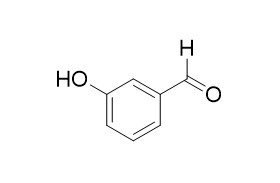3-Hydroxybenzaldehyde
3-Hydroxybenzaldehyde, a novel therapeutic agent, has shown vasculoprotective potency in both in vitro and in vivo. 3-Hydroxybenzaldehyde has antioxidant and antibacterial activityies.
Inquire / Order:
manager@chemfaces.com
Technical Inquiries:
service@chemfaces.com
Tel:
+86-27-84237783
Fax:
+86-27-84254680
Address:
1 Building, No. 83, CheCheng Rd., Wuhan Economic and Technological Development Zone, Wuhan, Hubei 430056, PRC
Providing storage is as stated on the product vial and the vial is kept tightly sealed, the product can be stored for up to
24 months(2-8C).
Wherever possible, you should prepare and use solutions on the same day. However, if you need to make up stock solutions in advance, we recommend that you store the solution as aliquots in tightly sealed vials at -20C. Generally, these will be useable for up to two weeks. Before use, and prior to opening the vial we recommend that you allow your product to equilibrate to room temperature for at least 1 hour.
Need more advice on solubility, usage and handling? Please email to: service@chemfaces.com
The packaging of the product may have turned upside down during transportation, resulting in the natural compounds adhering to the neck or cap of the vial. take the vial out of its packaging and gently shake to let the compounds fall to the bottom of the vial. for liquid products, centrifuge at 200-500 RPM to gather the liquid at the bottom of the vial. try to avoid loss or contamination during handling.
Asian Pac J Cancer Prev.2019, 20(1):65-72
Int J Mol Med.2020, 45(5):1514-1524.
Industrial Crops and Products2022, 188:115596.
Phytochem Anal.2024, 35(3):483-492.
Plos One.2020, 10.1371
J Cell Biochem.2018, 119(2):2231-2239
Int J Biol Macromol.2021, 199:189-200.
Pharmacia2024, 71:1-9.
Front Aging Neurosci.2018, 10:269
Life (Basel).2021, 11(7):616.
Related and Featured Products
Iet Nanobiotechnology, 2017, 11(6):630-636.
Antioxidant and antibacterial activity evaluation of 3-hydroxybenzaldehyde: The product of thymol oxidation by a new magnetic nanocatalyst.[Reference:
WebLink]
In this study maghemite nanoparticles were synthesised, they were first coated by sodium alginate and then by chitosan.
METHODS AND RESULTS:
Then acetanilide was introduced to maghemite nanoparticles that were coated by alginate and chitosan. Finally a silver complex was made with acetanilide and the magnetic nanocatalyst was synthesised. This nanocatalyst was used for the oxidation of thymol, then antioxidant and antibacterial properties of the oxidation product were assessed. Characterisation of this nanocatalyst was performed by Fourier transform infrared spectroscopy (FT-IR), X-ray diffractometer, scanning electron microscope (SEM) and value stream mapping. Creation of the product was confirmed by FT-IR and gas chromatography-mass spectroscopy. According to SEM, the size of the nanocatalyst was in the range of 46-70 nm. 3-Hydroxybenzaldehyde was obtained from the oxidation of thymol.
CONCLUSIONS:
It had antioxidant property as evident from Di (phenyl) -(2, 4, 6-trinitrophenyl) iminoazanium and the Folin-Ciocalteu method. Diffusion and dilution methods were used for the evaluation of the antibacterial activity. It was obvious from MIC that gram negative strains were more resistant than gram positive ones, and from minimum bactericidal concentration, it was obvious that Escherichia coli was the most resistant gram negative strain, and Bacillus subtilis was the most resistant gram positive strain.
Plos One, 2016, 11(3):e0149394.
Vasculoprotective Effects of 3-Hydroxybenzaldehyde against VSMCs Proliferation and ECs Inflammation.[Pubmed:
27002821]
3-Hydroxybenzaldehyde (3-HBA) is a precursor compound for phenolic compounds like Protocatechuic aldehyde (PCA). From recent reports, PCA has shown vasculoprotective potency, but the effects of 3-HBA remain unclear. The aim of this study is to investigate the vasculoprotective effects of 3-HBA in endothelial cells, vascular smooth muscle cells and various animal models.
METHODS AND RESULTS:
We tested effects of 3-HBA in both vitro and vivo. 3-HBA showed that it prevents PDGF-induced vascular smooth muscle cells (VSMCs) migration and proliferation from MTS, BrdU assays and inhibition of AKT phosphorylation. It arrested S and G0/G1 phase of VSMC cell cycle in PI staining and it also showed inhibited expression levels of Rb1 and CD1. In human umbilical vein endothelial cells (HUVECs), 3-HBA inhibited inflammatory markers and signaling molecules (VCAM-1, ICAM-1, p-NF-κB and p-p38). For ex vivo, 3-HBA has shown dramatic effects in suppressing the sprouting from aortic ring of Spargue Dawley (SD) rats. In vivo data supported the vasculoprotective effects of 3-HBA as it inhibited angiogenesis from Matrigel Plug assay in C57BL6 mouse, prevented ADP-induced thrombus generation, increased blood circulation after formation of thrombus, and attenuated neointima formation induced by common carotid artery balloon injury of SD rats.
CONCLUSIONS:
3-HBA, a novel therapeutic agent, has shown vasculoprotective potency in both in vitro and in vivo.



